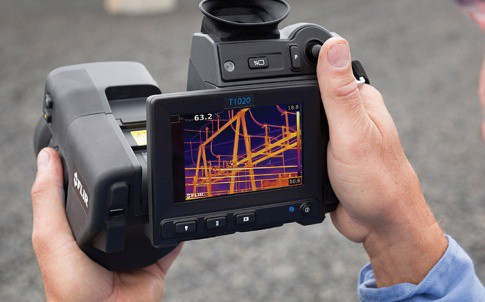
In the Northern hemisphere, November through to March is a particularly testing time for any energy supplier. Electrical load is at its highest and the likelihood of a breakdown is far greater so the quick and efficient detection of faulty power lines and connections is vital. For many utility companies thermal imaging has significantly boosted their ability for preventing failures. Indeed, for the Mason Public Utility District (PUD 3), in Washington State USA, investment in the latest FLIR thermal imaging camera allows them to scan for problems without getting out of their moving vehicle.
“We drive down the road and one of us scans out of the window with our FLIR T-Series camera to spot check. If we see something, we get out and do a full analysis,” explained Chris Jorgensen. “Before we started using thermal imaging in 2001 there was no way to do preventative maintenance; equipment failed, we went out and fixed it. Now, my work is like hunting, we scan every line and every piece of equipment looking for potential problems.”
The FLIR T500 Series has been designed for comfortable, continuous operation. Its hallmark feature is a 180-degree rotating optical block that allows the thermographer to image with ease at any angle. High quality imaging is assured through FLIR’s Vision Processing™ technology that combines proprietary adaptive filtering with MSX® multi spectral imaging and UltraMax® image enhancement. Complementing this is 1-Touch level and span that enables the thermographer to adjust the contrast on the image so the target stands out against the background; a very useful tool when scanning power generation equipment.
PUD 3’s investment in this model has helped the company find problems on cutouts, substation getaway structures, poor or failed connections and is even used for checking the integrity of constructions. Indeed, it has been responsible for huge cost savings on damage prevention and for underpinning the company’s reputation for good service.
A typical example is the discovery of a failing bushing on top of a regulator on a substation C-phase circuit. If this had remained undetected the estimated cost of the damage would have been the equivalent of £28,000 and the failure would have deprived around 3,000 customers of electricity. The company cites many similar examples with problem components such as hot taps, gang-operated switches and dead-end bells. The cost savings involved in preventing the failure of these structures far outweighs the cost of the thermal imaging investment.
PUD 3 monitors their loads with SCADA data acquisition software to determine what is under the greater amount of stress; this analysis informs the subsequent survey. Findings from the FLIR T-Series camera then allows engineers to grade the severity of the fault and schedule repairs.
“Thermal imaging really allows us to see what the naked eye can’t. Chris Jorgensen concludes. “It gives us great satisfaction when an imminent equipment failure is found and repaired before it causes an outage.”










New IET report examines grid transmission costs
I imagine the cables are heavily optimised but you do wonder whether the heat dissipation can be improved. Perhaps some lateral fins? Fitting them...